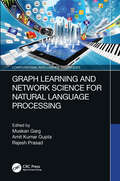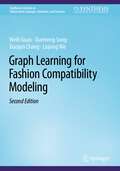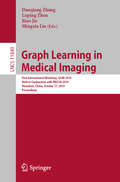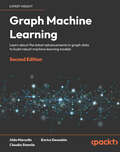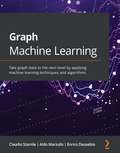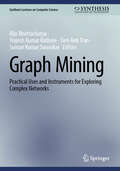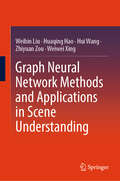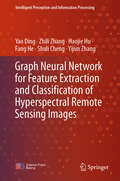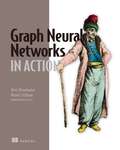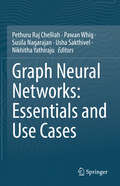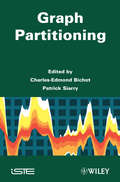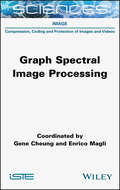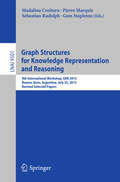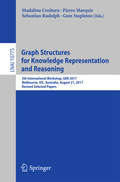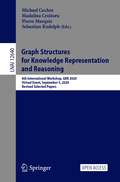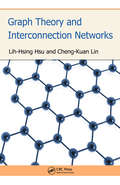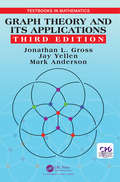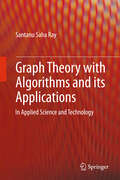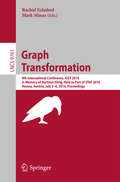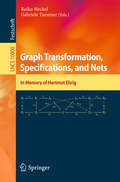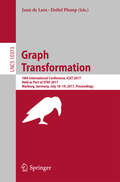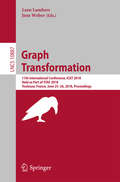- Table View
- List View
Graph Learning and Network Science for Natural Language Processing (Computational Intelligence Techniques)
by Muskan Garg, Amit Kumar Gupta and Rajesh PrasadAdvances in graph-based natural language processing (NLP) and information retrieval tasks have shown the importance of processing using the Graph of Words method. This book covers recent concrete information, from the basics to advanced level, about graph-based learning, such as neural network-based approaches, computational intelligence for learning parameters and feature reduction, and network science for graph-based NPL. It also contains information about language generation based on graphical theories and language models. Features: -Presents a comprehensive study of the interdisciplinary graphical approach to NLP -Covers recent computational intelligence techniques for graph-based neural network models -Discusses advances in random walk-based techniques, semantic webs, and lexical networks -Explores recent research into NLP for graph-based streaming data -Reviews advances in knowledge graph embedding and ontologies for NLP approaches This book is aimed at researchers and graduate students in computer science, natural language processing, and deep and machine learning.
Graph Learning for Fashion Compatibility Modeling (Synthesis Lectures on Information Concepts, Retrieval, and Services)
by Liqiang Nie Xuemeng Song Weili Guan Xiaojun ChangThis book sheds light on state-of-the-art theories for more challenging outfit compatibility modeling scenarios. In particular, this book presents several cutting-edge graph learning techniques that can be used for outfit compatibility modeling. Due to its remarkable economic value, fashion compatibility modeling has gained increasing research attention in recent years. Although great efforts have been dedicated to this research area, previous studies mainly focused on fashion compatibility modeling for outfits that only involved two items and overlooked the fact that each outfit may be composed of a variable number of items. This book develops a series of graph-learning based outfit compatibility modeling schemes, all of which have been proven to be effective over several public real-world datasets. This systematic approach benefits readers by introducing the techniques for compatibility modeling of outfits that involve a variable number of composing items. To deal with the challenging task of outfit compatibility modeling, this book provides comprehensive solutions, including correlation-oriented graph learning, modality-oriented graph learning, unsupervised disentangled graph learning, partially supervised disentangled graph learning, and metapath-guided heterogeneous graph learning. Moreover, this book sheds light on research frontiers that can inspire future research directions for scientists and researchers.
Graph Learning in Medical Imaging: First International Workshop, GLMI 2019, Held in Conjunction with MICCAI 2019, Shenzhen, China, October 17, 2019, Proceedings (Lecture Notes in Computer Science #11849)
by Daoqiang Zhang Mingxia Liu Luping Zhou Biao JieThis book constitutes the refereed proceedings of the First International Workshop on Graph Learning in Medical Imaging, GLMI 2019, held in conjunction with MICCAI 2019 in Shenzhen, China, in October 2019. The 21 full papers presented were carefully reviewed and selected from 42 submissions. The papers focus on major trends and challenges of graph learning in medical imaging and present original work aimed to identify new cutting-edge techniques and their applications in medical imaging.
Graph Machine Learning: Learn about the latest advancements in graph data to build robust machine learning algorithms
by Claudio Stamile Aldo Marzullo Enrico DeusebioEnhance your data science skills with this updated edition featuring new chapters on LLMs, temporal graphs, and updated examples with modern frameworks, including StellarGraph, PyTorch Geometric, and DGLKey FeaturesMaster new graph ML techniques through updated examples using PyTorch Geometric and Deep Graph Library (DGL)Explore GML frameworks and their main characteristicsLeverage LLMs for machine learning on graphs and learn about temporal learningPurchase of the print or Kindle book includes a free PDF eBookBook DescriptionGraph Machine Learning, Second Edition builds on its predecessor’s success, delivering the latest tools and techniques for this rapidly evolving field. From basic graph theory to advanced ML models, you’ll learn how to represent data as graphs to uncover hidden patterns and relationships, with practical implementation emphasized through refreshed code examples. This thoroughly updated edition replaces outdated examples with modern alternatives such as PyTorch and DGL, available on GitHub to support enhanced learning. The book also introduces new chapters on large language models and temporal graph learning, along with deeper insights into modern graph ML frameworks. Rather than serving as a step-by-step tutorial, it focuses on equipping you with fundamental problem-solving approaches that remain valuable even as specific technologies evolve. You will have a clear framework for assessing and selecting the right tools. By the end of this book, you’ll gain both a solid understanding of graph machine learning theory and the skills to apply it to real-world challenges.What you will learnImplement graph ML algorithms with examples in StellarGraph, PyTorch Geometric, and DGLApply graph analysis to dynamic datasets using temporal graph MLEnhance NLP and text analytics with graph-based techniquesSolve complex real-world problems with graph machine learningBuild and scale graph-powered ML applications effectivelyDeploy and scale your application seamlesslyWho this book is forThis book is for data scientists, ML professionals, and graph specialists looking to deepen their knowledge of graph data analysis or expand their machine learning toolkit. Prior knowledge of Python and basic machine learning principles is recommended.
Graph Machine Learning: Take graph data to the next level by applying machine learning techniques and algorithms
by Claudio Stamile Aldo Marzullo Enrico DeusebioBuild machine learning algorithms using graph data and efficiently exploit topological information within your modelsKey FeaturesImplement machine learning techniques and algorithms in graph dataIdentify the relationship between nodes in order to make better business decisionsApply graph-based machine learning methods to solve real-life problemsBook DescriptionGraph Machine Learning provides a new set of tools for processing network data and leveraging the power of the relation between entities that can be used for predictive, modeling, and analytics tasks. You will start with a brief introduction to graph theory and graph machine learning, understanding their potential. As you proceed, you will become well versed with the main machine learning models for graph representation learning: their purpose, how they work, and how they can be implemented in a wide range of supervised and unsupervised learning applications. You'll then build a complete machine learning pipeline, including data processing, model training, and prediction in order to exploit the full potential of graph data. Moving ahead, you will cover real-world scenarios such as extracting data from social networks, text analytics, and natural language processing (NLP) using graphs and financial transaction systems on graphs. Finally, you will learn how to build and scale out data-driven applications for graph analytics to store, query, and process network information, before progressing to explore the latest trends on graphs. By the end of this machine learning book, you will have learned essential concepts of graph theory and all the algorithms and techniques used to build successful machine learning applications.What you will learnWrite Python scripts to extract features from graphsDistinguish between the main graph representation learning techniquesBecome well-versed with extracting data from social networks, financial transaction systems, and moreImplement the main unsupervised and supervised graph embedding techniquesGet to grips with shallow embedding methods, graph neural networks, graph regularization methods, and moreDeploy and scale out your application seamlesslyWho this book is forThis book is for data analysts, graph developers, graph analysts, and graph professionals who want to leverage the information embedded in the connections and relations between data points to boost their analysis and model performance. The book will also be useful for data scientists and machine learning developers who want to build ML-driven graph databases. A beginner-level understanding of graph databases and graph data is required. Intermediate-level working knowledge of Python programming and machine learning is also expected to make the most out of this book.
Graph Mining: Practical Uses and Instruments for Exploring Complex Networks (Synthesis Lectures on Computer Science)
by Tien Anh Tran Suman Kumar Swarnkar Yogesh Kumar Rathore Riju BhattacharyaThis book provides a thorough introduction to graph mining and addresses foundational concepts and advanced techniques along with practical applications across various fields. As graphs have become increasingly vital for data representation in domains such as social network analysis, bioinformatics, and transportation, there is a growing demand for a comprehensive source that covers both theory and practical insights. This book seeks to fill that gap by offering clear explanations, practical examples, and actionable insights, making complex graph mining techniques accessible to students, postgraduate readers, and researchers. The authors also provide an extensive investigation into the process of gaining insightful knowledge from graph representations, ranging from interpreting intricate relationships to decoding complex data structures. Readers will learn to identify anomalous patterns, locate communities, arrange nodes, predict connections, and evaluate graphs effectively.
Graph Neural Network Methods and Applications in Scene Understanding
by Weibin Liu Weiwei Xing Hui Wang Huaqing Hao Zhiyuan ZouThe book focuses on graph neural network methods and applications for scene understanding. Graph Neural Network is an important method for graph-structured data processing, which has strong capability of graph data learning and structural feature extraction. Scene understanding is one of the research focuses in computer vision and image processing, which realizes semantic segmentation and object recognition of image or video. In this book, the algorithm, system design and performance evaluation of scene understanding based on graph neural networks have been studied. First, the book elaborates the background and basic concepts of graph neural network and scene understanding, then introduces the operation mechanism and key methodological foundations of graph neural network. The book then comprehensively explores the implementation and architectural design of graph neural networks for scene understanding tasks, including scene parsing, human parsing, and video object segmentation. The aim of this book is to provide timely coverage of the latest advances and developments in graph neural networks and their applications to scene understanding, particularly for readers interested in research and technological innovation in machine learning, graph neural networks and computer vision. Features of the book include self-supervised feature fusion based graph convolutional network is designed for scene parsing, structure-property based graph representation learning is developed for human parsing, dynamic graph convolutional network based on multi-label learning is designed for human parsing, and graph construction and graph neural network with transformer are proposed for video object segmentation.
Graph Neural Network for Feature Extraction and Classification of Hyperspectral Remote Sensing Images (Intelligent Perception and Information Processing)
by Yijun Zhang Yao Ding Zhili Zhang Haojie Hu Fang He Shuli ChengThis book deals with hyperspectral image classification using graph neural network methods, focusing on classification model designing, graph information dissemination, and graph construction. In the book, various graph neural network based classifiers have been proposed for hyperspectral image classification to improve the classification accuracy. This book has promoted the application of graph neural network in hyperspectral image classification, providing reference for remote sensing image processing. It will be a useful reference for researchers in remote sensing image processing and image neural network design.
Graph Neural Network for Hyperspectral Image Clustering (Intelligent Perception and Information Processing)
by Jie Feng Yao Ding Zhili Zhang Haojie Hu Renxiang Guan Zhiyong LvThis book investigates detailed hyperspectral image clustering using graph neural network (graph learning) methods, focusing on the overall construction of the model, design of self-supervised methods, image pre-processing, and feature extraction of graph information. Multiple graph neural network-based clustering methods for hyperspectral images are proposed, effectively improving the clustering accuracy of hyperspectral images and taking an important step towards the practical application of hyperspectral images. This book is innovative in content and emphasizes the integration of theory with practice, which can be used as a reference book for graduate students, senior undergraduate students, researchers, and engineering technicians in related majors such as electronic information engineering, computer application technology, automation, instrument science and technology, remote sensing.
Graph Neural Networks in Action (In Action)
by Keita Broadwater Namid StillmanA hands-on guide to powerful graph-based deep learning models.Graph Neural Networks in Action teaches you to build cutting-edge graph neural networks for recommendation engines, molecular modeling, and more. This comprehensive guide contains coverage of the essential GNN libraries, including PyTorch Geometric, DeepGraph Library, and Alibaba&’s GraphScope for training at scale. In Graph Neural Networks in Action, you will learn how to: • Train and deploy a graph neural network • Generate node embeddings • Use GNNs at scale for very large datasets • Build a graph data pipeline • Create a graph data schema • Understand the taxonomy of GNNs • Manipulate graph data with NetworkX In Graph Neural Networks in Action you&’ll learn how to both design and train your models, and how to develop them into practical applications you can deploy to production. Go hands-on and explore relevant real-world projects as you dive into graph neural networks perfect for node prediction, link prediction, and graph classification. Foreword by Matthias Fey. About the technology Graphs are a natural way to model the relationships and hierarchies of real-world data. Graph neural networks (GNNs) optimize deep learning for highly-connected data such as in recommendation engines and social networks, along with specialized applications like molecular modeling for drug discovery. About the book Graph Neural Networks in Action teaches you how to analyze and make predictions on data structured as graphs. You&’ll work with graph convolutional networks, attention networks, and auto-encoders to take on tasks like node classification, link prediction, working with temporal data, and object classification. Along the way, you&’ll learn the best methods for training and deploying GNNs at scale—all clearly illustrated with well-annotated Python code! What's inside • Train and deploy a graph neural network • Generate node embeddings • Use GNNs for very large datasets • Build a graph data pipeline About the reader For Python programmers familiar with machine learning and the basics of deep learning. About the author Keita Broadwater, PhD, MBA is a seasoned machine learning engineer. Namid Stillman, PhD is a research scientist and machine learning engineer with more than 20 peer-reviewed publications. Table of Contents Part 1 1 Discovering graph neural networks 2 Graph embeddings Part 2 3 Graph convolutional networks and GraphSAGE 4 Graph attention networks 5 Graph autoencoders Part 3 6 Dynamic graphs: Spatiotemporal GNNs 7 Learning and inference at scale 8 Considerations for GNN projects A Discovering graphs B Installing and configuring PyTorch Geometric
Graph Neural Networks: Essentials and Use Cases
by Pethuru Raj Chelliah Usha Sakthivel Susila Nagarajan Pawan Whig Nikhitha YathirajuThis book explains the technologies and tools that underpin GNNs, offering a clear and practical guide to their industrial applications and use cases. AI engineers, data scientists, and researchers in AI and graph theory will find detailed insights into the latest trends and innovations driving this dynamic field. With practical chapters demonstrating how GNNs are reshaping various industry verticals—and how they complement advances in generative, agentic, and physical AI—this book is an essential resource for understanding and leveraging their potential. The neural network paradigm has surged in popularity for its ability to uncover hidden patterns within vast datasets. This transformative technology has spurred global innovations, particularly through the evolution of deep neural networks (DNNs). Convolutional neural networks (CNNs) have revolutionized computer vision, while recurrent neural networks (RNNs) and their advanced variants have automated natural language processing tasks such as speech recognition, translation, and content generation. Traditional DNNs primarily handle Euclidean data, yet many real-world problems involve non-Euclidean data—complex relationships and interactions naturally represented as graphs. This challenge has driven the rise of graph neural networks (GNNs), an approach that extends deep learning into new domains. GNNs are powerful models designed to work with graph-structured data, where nodes represent individual data points and edges denote the relationships between them. Several variants have emerged: Graph Convolutional Networks (GCNs): These networks learn from a node&’s local neighborhood by aggregating information from adjacent nodes, updating the node&’s representation in the process. Graph Attentional Networks (GATs): By incorporating attention mechanisms, GATs focus on the most relevant neighbors during aggregation, enhancing model performance. Graph Recurrent Networks (GRNs): These networks combine principles from RNNs with graph structures to capture dynamic relationships within the data. GNNs are applied in a variety of advanced use cases, including node classification, link prediction, graph clustering, anomaly detection, recommendation systems, and also in natural language processing and computer vision. They help forecast traffic patterns, analyze molecular structures, verify programs, predict social influence, model electronic health records, and map brain networks.
Graph Partitioning
by Patrick Siarry Charles-Edmond BichotGraph partitioning is a theoretical subject with applications in many areas, principally: numerical analysis, programs mapping onto parallel architectures, image segmentation, VLSI design. During the last 40 years, the literature has strongly increased and big improvements have been made. This book brings together the knowledge accumulated during many years to extract both theoretical foundations of graph partitioning and its main applications.
Graph Polynomials (Discrete Mathematics and Its Applications)
by Yongtang Shi; Matthias Dehmer; Xueliang Li; Ivan GutmanThis book covers both theoretical and practical results for graph polynomials. Graph polynomials have been developed for measuring combinatorial graph invariants and for characterizing graphs. Various problems in pure and applied graph theory or discrete mathematics can be treated and solved efficiently by using graph polynomials. Graph polynomials have been proven useful areas such as discrete mathematics, engineering, information sciences, mathematical chemistry and related disciplines.
Graph Spectral Image Processing
by Enrico Magli Gene CheungGraph spectral image processing is the study of imaging data from a graph frequency perspective. Modern image sensors capture a wide range of visual data including high spatial resolution/high bit-depth 2D images and videos, hyperspectral images, light field images and 3D point clouds. The field of graph signal processing – extending traditional Fourier analysis tools such as transforms and wavelets to handle data on irregular graph kernels – provides new flexible computational tools to analyze and process these varied types of imaging data. Recent methods combine graph signal processing ideas with deep neural network architectures for enhanced performances, with robustness and smaller memory requirements.The book is divided into two parts. The first is centered on the fundamentals of graph signal processing theories, including graph filtering, graph learning and graph neural networks. The second part details several imaging applications using graph signal processing tools, including image and video compression, 3D image compression, image restoration, point cloud processing, image segmentation and image classification, as well as the use of graph neural networks for image processing.
Graph Structures for Knowledge Representation and Reasoning
by Madalina Croitoru Pierre Marquis Sebastian Rudolph Gem StapletonThis book constitutes the thoroughly refereed post-conference proceedings of the 4th International Workshop on Graph Structures for Knowledge Representation and Reasoning, GKR 2015, held in Buenos Aires, Argentina, in July 2015, associated with IJCAI 2015, the 24th International Joint Conference on Artificial Intelligence. The 9 revised full papers presented were carefully reviewed and selected from 10 submissions. The papers feature current research involved in the development and application of graph-based knowledge representation formalisms and reasoning techniques. They address the following topics: argumentation; conceptual graphs; RDF; and representations of constraint satisfaction problems.
Graph Structures for Knowledge Representation and Reasoning: 5th International Workshop, Gkr 2017, Melbourne, Vic, Australia, August 21, 2017, Revised Selected Papers (Lecture Notes in Computer Science #10775)
by Madalina Croitoru Pierre Marquis Sebastian Rudolph Gem StapletonThis book constitutes the thoroughly refereed post-conference proceedings of the 5th International Workshop on Graph Structures for Knowledge Representation and Reasoning, GKR 2017, held in Melbourne, VIC, Australia, in August 2017, associated with IJCAI 2017, the 26th International Joint Conference on Artificial Intelligence. The 7 revised full papers presented were reviewed and selected from 9 submissions. The contributions address various issues for knowledge representation and reasoning and the common graph-theoretic background allows to bridge the gap between the different communities.
Graph Structures for Knowledge Representation and Reasoning: 6th International Workshop, GKR 2020, Virtual Event, September 5, 2020, Revised Selected Papers (Lecture Notes in Computer Science #12640)
by Madalina Croitoru Pierre Marquis Sebastian Rudolph Michael CochezThis open access book constitutes the thoroughly refereed post-conference proceedings of the 6th International Workshop on Graph Structures for Knowledge Representation and Reasoning, GKR 2020, held virtually in September 2020, associated with ECAI 2020, the 24th European Conference on Artificial Intelligence.The 7 revised full papers presented together with 2 invited contributions were reviewed and selected from 9 submissions. The contributions address various issues for knowledge representation and reasoning and the common graph-theoretic background, which allows to bridge the gap between the different communities.
Graph Theory and Interconnection Networks
by Lih-Hsing Hsu Cheng-Kuan LinThe advancement of large scale integrated circuit technology has enabled the construction of complex interconnection networks. Graph theory provides a fundamental tool for designing and analyzing such networks. Graph Theory and Interconnection Networks provides a thorough understanding of these interrelated topics. After a brief introduction to gra
Graph Theory and Its Applications (Textbooks in Mathematics)
by Mark Anderson Jonathan L. Gross Jay YellenGraph Theory and Its Applications, Third Edition is the latest edition of the international, bestselling textbook for undergraduate courses in graph theory, yet it is expansive enough to be used for graduate courses as well. The textbook takes a comprehensive, accessible approach to graph theory, integrating careful exposition of classical developments with emerging methods, models, and practical needs. The authors’ unparalleled treatment is an ideal text for a two-semester course and a variety of one-semester classes, from an introductory one-semester course to courses slanted toward classical graph theory, operations research, data structures and algorithms, or algebra and topology. Features of the Third Edition Expanded coverage on several topics (e.g., applications of graph coloring and tree-decompositions) Provides better coverage of algorithms and algebraic and topological graph theory than any other text Incorporates several levels of carefully designed exercises that promote student retention and develop and sharpen problem-solving skills Includes supplementary exercises to develop problem-solving skills, solutions and hints, and a detailed appendix, which reviews the textbook’s topics About the Authors Jonathan L. Gross is a professor of computer science at Columbia University. His research interests include topology and graph theory. Jay Yellen is a professor of mathematics at Rollins College. His current areas of research include graph theory, combinatorics, and algorithms. Mark Anderson is also a mathematics professor at Rollins College. His research interest in graph theory centers on the topological or algebraic side.
Graph Theory with Algorithms and its Applications
by Santanu Saha RayThe book has many important features which make it suitable for both undergraduate and postgraduate students in various branches of engineering and general and applied sciences. The important topics interrelating Mathematics & Computer Science are also covered briefly. The book is useful to readers with a wide range of backgrounds including Mathematics, Computer Science/Computer Applications and Operational Research. While dealing with theorems and algorithms, emphasis is laid on constructions which consist of formal proofs, examples with applications. Uptill, there is scarcity of books in the open literature which cover all the things including most importantly various algorithms and applications with examples.
Graph Transformation
by Francesco Parisi-Presicce Bernhard WestfechtelThis book constitutes the proceedings of the 8th International Conference on Graph Transformations, ICGT 2015, held in L'Aquila, Italy, in July 2015. The 15 full papers presented together with 3 short papers and 1 keynote were carefully reviewed and selected from 27 submissions. The papers are organized in topical sections on foundations; applications: technical papers, and tool presentations.
Graph Transformation
by Rachid Echahed Mark MinasThis book constitutes the refereed proceedings of the 9th International Conference on Graph Transformation, ICGT 2016, held as part of STAF 2016, in Vienna, Austria, in July 2016. The 14 papers presented in this were carefully reviewed and selected from 33 submissions. They were organized in topical sections named: foundations, tools and algorithms, queries, and applications. The book also contains one keynote paper in full paper length. The book is dedicated to Hartmut Ehrig, one of the fathers and most productive members of the Graph Transformation community, who passed away in 2016. An obituary is included in the front matter of the volume.
Graph Transformation, Specifications, and Nets
by Reiko Heckel Gabriele TaentzerThis volume pays tribute to the scientific achievements of Hartmut Ehrig, who passed away in March 2016.The contributions represent a selection from a symposium, held in October 2016 at TU Berlin, commemorating Hartmut’ s life and work as well as other invited papers in the areas he was active in. These areas include Graph Transformation, Model Transformation, Concurrency Theory, in particular Petri Nets, Algebraic Specification, and Category Theory in Computer Science.
Graph Transformation: 10th International Conference, ICGT 2017, Held as Part of STAF 2017, Marburg, Germany, July 18-19, 2017, Proceedings (Lecture Notes in Computer Science #10373)
by Juan de Lara and Detlef PlumpThis book constitutes the refereed proceedings of the 10th International Conference on Graph Transformation, ICGT 2017, held as part of STAF 2017, in Marburg, Germany, in July 2017.The 14 papers presented were carefully reviewed and selected from 23 submissions. The papers cover a wide range of topics including theoretical approaches to graph transformation and their verification, model-driven engineering, chemical reactions as well as various applications. They are organized in the following topical sections: foundations; graph language and parsing; analysis and verification; and model transformation and tools.
Graph Transformation: 11th International Conference, ICGT 2018, Held as Part of STAF 2018, Toulouse, France, June 25–26, 2018, Proceedings (Lecture Notes in Computer Science #10887)
by Leen Lambers Jens WeberThis book constitutes the refereed proceedings of the 11th International Conference on Graph Transformation, ICGT 2018, held as part of STAF 2018, in Toulouse, France, in June 2018.The 9 full papers, 2 short papers and 1 keynote presented in this book were carefully reviewed and selected from 16 submissions. The papers deal with the following topics: graph languages; graph transformation formalisms; parallel independence and conflicts; and graph conditions and verification.
